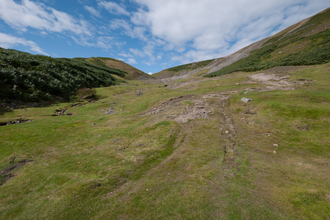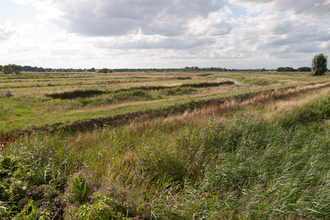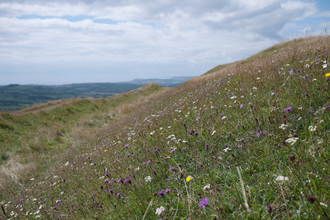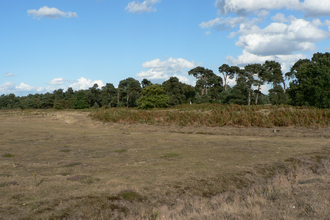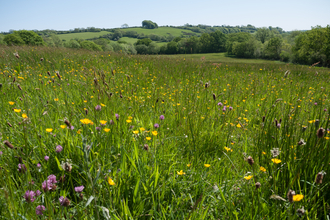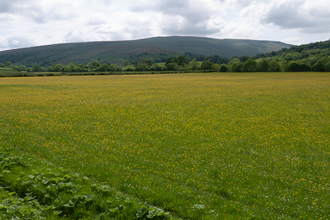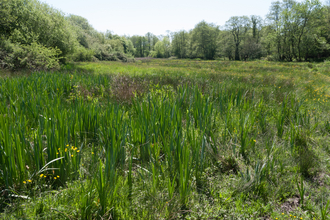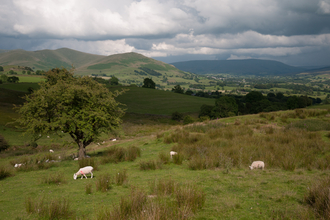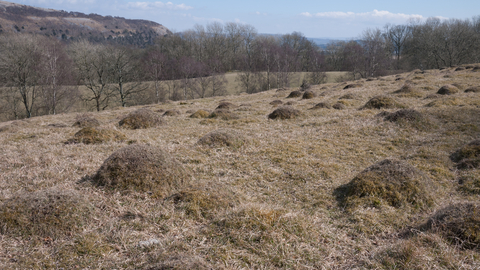


Upland calcareous grassland
What is it?
Found in upland landscapes above about 300 metres, including on limestones, some sandstones and volcanic rocks, upland calcaerous grassland can also be found around exposures of limestone pavement. Smaller in area than upland acid grassland, its distribution is limited by the underlying base-rich rocks (those containing high levels of chemical bases like calcium or magnesium).
This habitat supports a range of vegetation types, which vary according to the depth of the soil, the climate and altitude. Generally present in patches intermingled with moorland, this mixed habitat, coupled with the lime-rich soils, supports a large variety of species. Most is used as rough grazing and, as livestock preferentially graze it, the expanse of sheep’s fescue and wild thyme is generally shorter and greener than the surrounding vegetation and can be picked out at a distance.
Above about 650 metres, the addition of moss campion and scarce and rare arctic-alpine plants (like cyphel, alpine mouse-ear, alpine cinquefoil and purple saxifrage) indicate high montane heath and snow-bed communities, while swards on ungrazed mountain ledges support species such as wild angelica, globeflower and roseroot.
Why is it like this?
The majority of upland calcareous grassland is a result of prehistoric woodland clearance, followed by livestock grazing. Left ungrazed, it would generally revert to scrub and upland mixed ash wood. Many of the species found in this upland habitat are different to those found on lowland limestones, thanks to the higher rainfall (causing nutrients to leach from the soil), and the colder climate.
Species that typically indicate acidic conditions sometimes occur here, such as mat grass, tormentil and even heather. Where soils are very thin and do little to disguise the underlying limestone, blue moor-grass and common rock-rose are common, and may be accompanied by rarities. Slightly deeper soil supports less lime-loving species such as common bent grass, self-heal, meadow oat grass and quaking grass. In areas with a particularly wet climate, like the Lake District and the Highlands, alpine lady’s mantle may be abundant.
In the north of Scotland, mountain avens is characteristic in a montane, heath-like community that can be found down to sea level - a surviving remnant of the vegetation that developed across Britain on suitable soils after the last glaciation before it was mostly overgrown with more robust herbs, scrub and trees – it is now one of the rarest vegetation types in the UK.
Distribution in the UK
Just under 20,000 hectares are scattered throughout the UK uplands.
What to look for
The colder, windier conditions of southern limestones limits the abundance of invertebrates, but rare species like the scarce northern brown argus, whose caterpillars feed on common rock-rose, can be found in this habitat.
Botanists will be delighted by a host of scarce and rare plants, including many arctic-alpine species (characteristic of northern tundra and high mountains further south). This includes rock whitlow-grass, shrubby cinquefoil, spring gentian and limestone bedstraw, and bird’s-eye primrose, Scottish asphodel and rare sedges in damp flushes. In Teesdale, a famous assemblage of both arctic-alpines and lowland rare plants is found on ‘sugar’ limestone, including Teesdale sandwort and Teesdale violet.
Conservation
Many sites are heavily sheep-grazed, as is the case with most of the uplands. Relaxation of grazing pressure and use of cattle can allow more plants to flower, although a reduction in grazing can also allow plant litter to build up, reducing the calcareous influence of the substrate. Inappropriate cattle grazing can cause trampling damage, while the removal of grazing altogether would eventually lead to the development of upland mixed ash wood. Ensuring appropriate grazing is an ongoing challenge and will be particularly relevant in the face of climate change to ensure that more competitive species do not displace arctic alpines.

